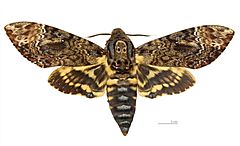Sphinginae facts for kids
Quick facts for kids Sphinginae |
|
|---|---|
 |
|
| The death's-head hawkmoth Acherontia lachesis | |
| Scientific classification | |
| Kingdom: | |
| Phylum: | |
| Class: | |
| Order: | |
| Superfamily: |
Bombycoidea
|
| (unranked): | |
| Family: | |
| Subfamily: |
Sphinginae
|
The Sphinginae are a group of moths known as hawkmoths. They belong to a larger family called Sphingidae. These moths are part of the order Lepidoptera, which includes all butterflies and moths.
Some well-known Sphinginae moths include the pink-spotted hawkmoth. This moth is very common and easy to spot. Another famous one is the Death's-head hawkmoth (Acherontia species). This moth is known from the movie Silence of the Lambs. There is also Xanthopan morgani, which has a very long tongue, called a proboscis.
Contents
What Makes Sphinginae Moths Special?
Sphinginae moths are often large and strong flyers. Many of them fly at dusk or night, but some are active during the day. They are known for their fast, direct flight, which looks a bit like a hummingbird.
Their Amazing Proboscis
One of the most interesting features of these moths is their proboscis. This is a long, tube-like mouthpart that they keep coiled up when not in use. When they want to feed, they unroll it to reach nectar deep inside flowers. The proboscis can be very long, especially in species like Xanthopan morgani. This moth has a proboscis that can be over 30 centimeters (12 inches) long!
How They Fly
Hawkmoths are excellent fliers. They can hover in front of flowers while feeding. Their wings beat very quickly, making a humming sound. This special way of flying helps them reach nectar from many different types of flowers.
Life Cycle of a Sphinginae Moth
Like all moths, Sphinginae go through a complete metamorphosis. This means they change completely during their life.
Eggs and Larvae
The life cycle starts when the female moth lays tiny eggs. These eggs usually hatch into larvae, which are also called caterpillars. Sphinginae caterpillars are often large and colorful. Many have a small "horn" or spike at their rear end. This horn is harmless and is not a stinger.
Caterpillars spend their time eating leaves. They grow very quickly and shed their skin several times. Each time they shed their skin, it is called an instar.
Pupae
Once a caterpillar is fully grown, it stops eating. It then changes into a pupa. For many Sphinginae, the pupa stage happens underground in a small chamber. The pupa looks like a hard, brown case. Inside this case, the caterpillar's body transforms into an adult moth. This stage can last for weeks or even months.
Adult Moths
When the adult moth is ready, it breaks out of the pupal case. It then expands its wings and waits for them to harden. Once its wings are strong, the adult moth can fly. Adult moths live to mate and lay eggs, starting the cycle all over again. They mostly feed on nectar from flowers.
Where Do They Live?
Sphinginae moths can be found all over the world. They live in many different habitats, from forests to gardens. They are especially common in warmer regions. Different species prefer different types of plants for their caterpillars to eat.
Famous Sphinginae Moths
Let's look at some of the interesting Sphinginae moths mentioned earlier.
Pink-Spotted Hawkmoth (Agrius cingulata)
This moth is also known as the sweet potato hornworm. Its caterpillars feed on plants like sweet potatoes and morning glories. The adult moth is quite large and has bright pink bands on its body. It is often seen at dusk, visiting flowers.
Death's-Head Hawkmoth (Acherontia species)
There are three species of death's-head hawkmoths. They are famous for a skull-like pattern on their thorax (the middle part of their body). These moths are unique because they can make a squeaking sound. They are also known for raiding beehives to steal honey! Their proboscis is short and strong, perfect for piercing the wax cells of a beehive.
Darwin's Orchid Moth (Xanthopan morgani)
This moth is famous because of Charles Darwin. He predicted its existence after seeing an orchid in Madagascar with a very long nectar spur. He believed there must be a moth with an equally long proboscis to pollinate it. Years later, this moth was discovered, proving Darwin's prediction right! It has one of the longest proboscises of any insect.
Importance to Nature
Sphinginae moths play an important role in nature. Many of them are excellent pollinators. As they visit flowers to drink nectar, they pick up pollen and carry it to other flowers. This helps plants reproduce. Some plants rely only on these moths for pollination, especially those with deep, tube-shaped flowers.
See also
 In Spanish: Esfinginos para niños
In Spanish: Esfinginos para niños

